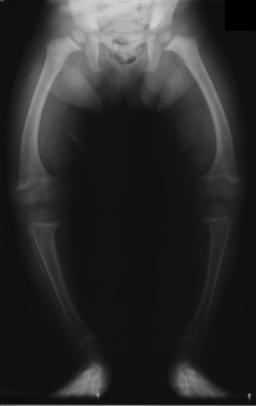OMIM 179800 MeSH D000141 | MedlinePlus 000493 | |
 | ||
Distal renal tubular acidosis (dRTA) or Type 1 renal tubular acidosis (RTA) is the classical form of RTA, being the first described. Distal RTA is characterized by a failure of acid secretion by the alpha intercalated cells of the cortical collecting duct of the distal nephron. This failure of acid secretion may be due to a number of causes, and it leads to an inability to acidify the urine to a pH of less than 5.3.
Contents
Symptoms
Because renal excretion is the primary means of eliminating acid from the body, there is consequently a tendency towards acidemia. This leads to the clinical features of dRTA:
The symptoms and sequelae of dRTA are variable and range from being completely asymptomatic, to loin pain and hematuria from kidney stones, to failure to thrive and severe rickets in childhood forms as well as possible renal failure and even death.
dRTA commonly leads to sodium loss and volume contraction, which causes a compensatory increase in blood levels of aldosterone. Aldosterone causes increased resorption of sodium and loss of potassium in the collecting duct of the kidney, so these increased aldosterone levels cause the hypokalemia which is a common symptom of dRTA.
Diagnosis
The acidosis is variable, and one may have dRTA with alpha intercalated cell failure without necessarily being acidemic; this is termed incomplete dRTA. The diagnosis of dRTA can be made by the observation of a urinary pH of greater than 5.3 in the face of a systemic acidemia (usually taken to be a serum bicarbonate of 20 mmol/l or less). In the case of an incomplete dRTA, failure to acidify the urine following an oral acid loading challenge is often used as a test. The test usually performed is the short ammonium chloride test, in which ammonium chloride capsules are used as the acid load. More recently, an alternative test using furosemide and fludrocortisone has been described.
Interestingly, dRTA has been proposed as a possible diagnosis for the unknown malady plaguing Tiny Tim in Charles Dickens' A Christmas Carol.
Causes
Treatment
This is relatively straightforward. It involves correction of the acidemia with oral sodium bicarbonate, sodium citrate or potassium citrate. This will correct the acidemia and reverse bone demineralisation. Hypokalemia and urinary stone formation and nephrocalcinosis can be treated with potassium citrate tablets which not only replace potassium but also inhibit calcium excretion and thus do not exacerbate stone disease as sodium bicarbonate or citrate may do.
